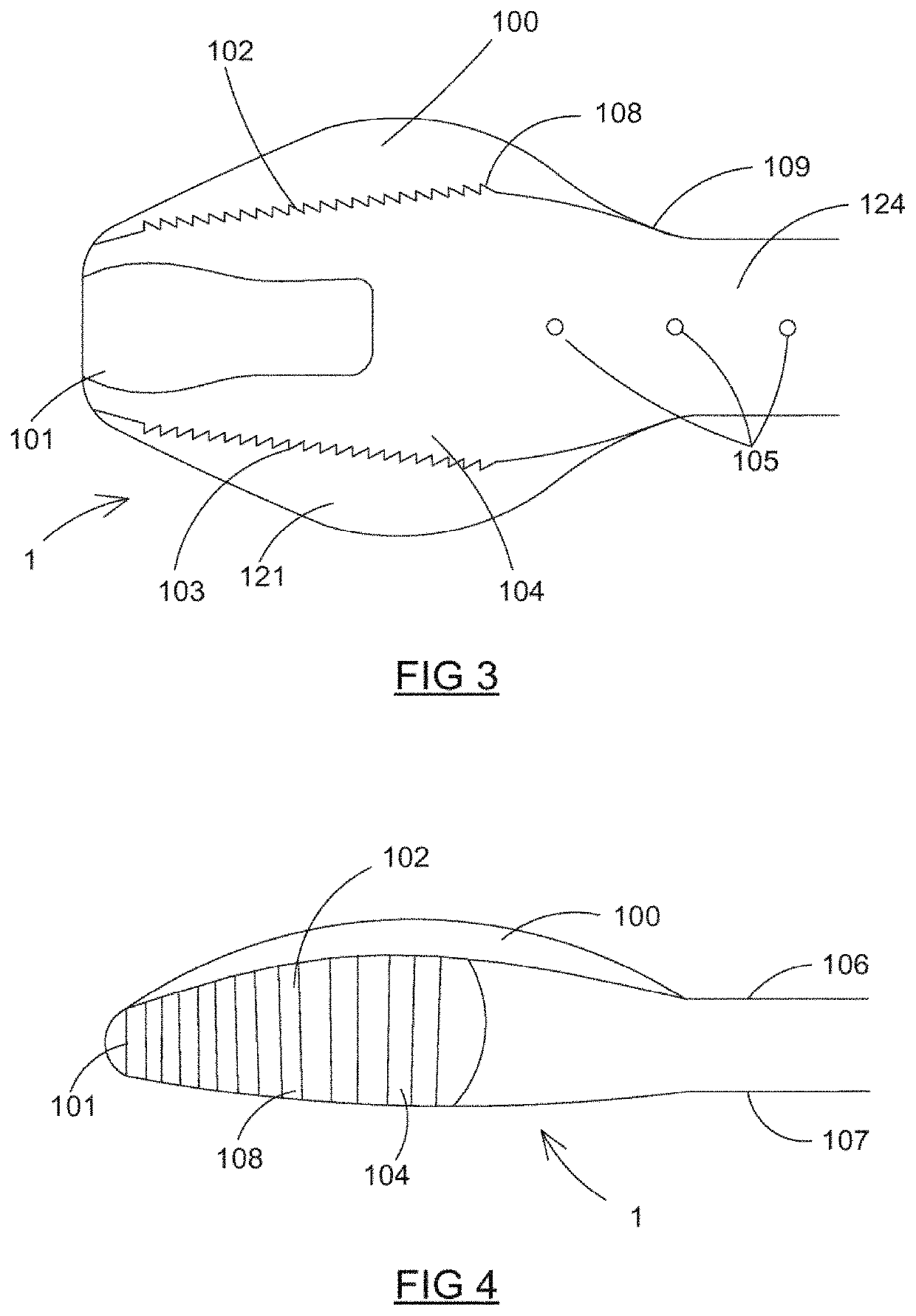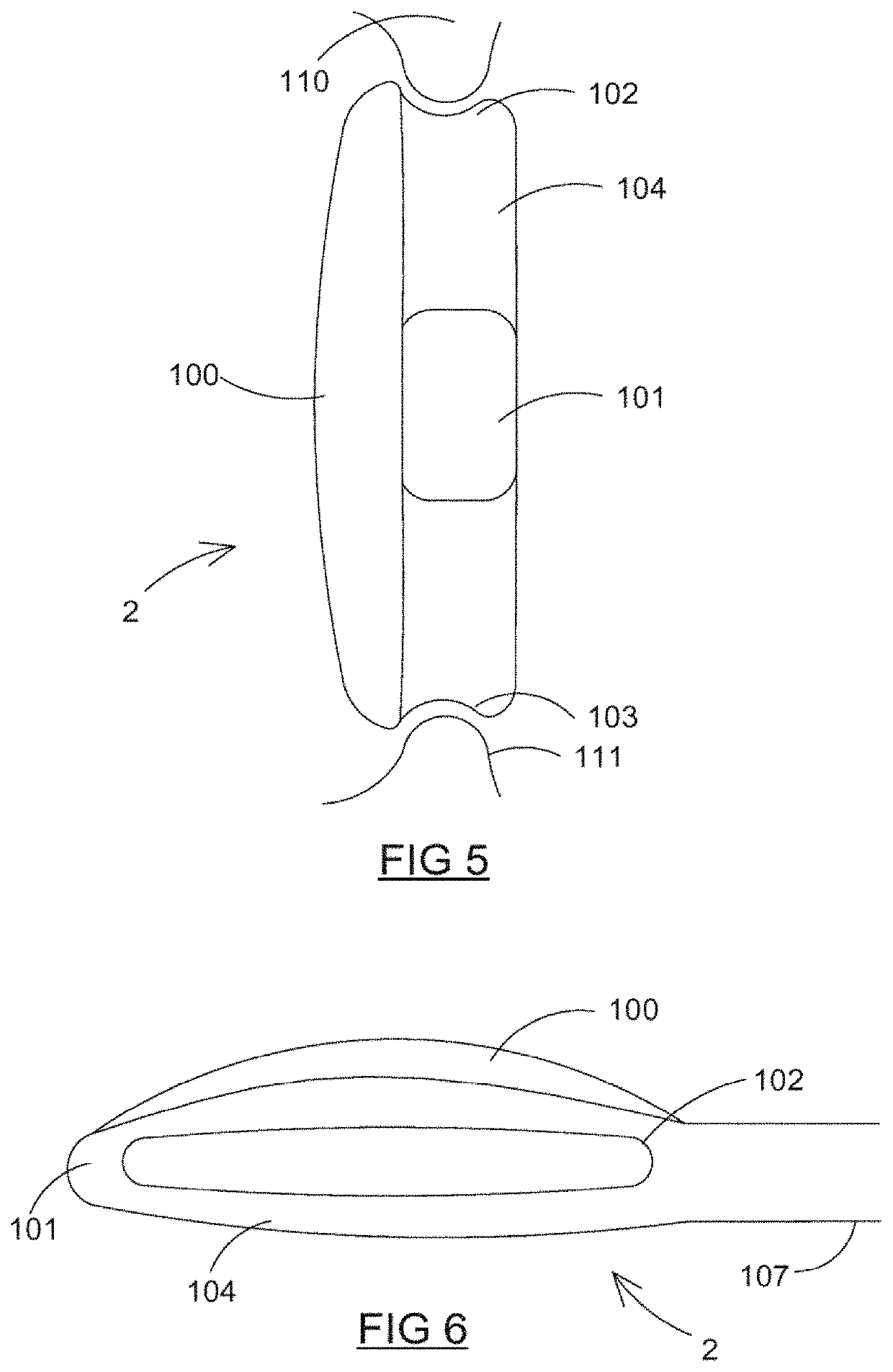Device for removing material from the oral cavity of a patient
- Summary
- Abstract
- Description
- Claims
- Application Information
AI Technical Summary
Benefits of technology
Problems solved by technology
Method used
Image
Examples
example 1
First Embodiment
Device where a Patient is Fully Dentate in a Region where a Bite Block is to be Used
[0137]This is a first embodiment of a device 1 of the present invention. Here a bite block 104 is provided that is shaped to be held between upper and lower rows of teeth of a subject undergoing a procedure within the oral cavity. The procedure may be a dental procedure, although the device 1 can be used for any desired procedure where it is desired to remove material from the oral activity. This embodiment is illustrated by FIGS. 1 to 4, 12 and 13.
[0138]The device 1 includes a buccal plate 100, which is also referred to herein as a cheek protector (although it is not limited to such a use, as discussed later). The buccal plate 100 is smooth to reduce the risk of trauma to the soft tissues. It has a convex outer surface, so as to complement the natural anatomy of the buccal mucosa. This allows a good fit and also provides comfort to the patient during use. It is streamlined in shape a...
example 2
Second Embodiment
Device where a Patient is Edentulous in a Region where a Bite Block is to be Used
[0160]This device 2 is similar in various respects to the device 1 discussed in Example 1. The main difference is that in Example 2, which is illustrated by FIGS. 5 to 7, the upper 102 and lower 103 bite surfaces of the bite block 104 are formed by generally concave channels or grooves that receive upper and lower gums 110, 111 (rather than ridges that engage upper and lower teeth). The channels / grooves are shown in FIGS. 5 and 6 and are illustrated by dotted lines in FIG. 7.
[0161]In this example the device 2 is held in place by gums 110, 111 (also known as the maxillary and mandibular edentulous ridges) that fit into channels and apply pressure to the bite block via said channels. For the purposes of the present invention this pressure is considered to be a “bite” on the bite block 104. Although teeth are absent in the region of the bite block 104, the distance between the upper and lo...
example 3
Third Embodiment
Device where a Bite Block is to be Held Between Upper Teeth and a Lower Gum
[0164]In this embodiment a patient is partially edentulous, having lower teeth missing in the vicinity where the bite block is to be used, but having upper teeth 110 present. This embodiment can in some respects be considered a mixture of the embodiments discussed in Examples 1 and 2. (Again, corresponding reference numbers have been used, where appropriate).
[0165]As can be seen from FIGS. 8 and 9, the bite block 104 of the device 3 is held in place between upper teeth 110 and a lower gum 111. The upper teeth 110 contact ridges 108 of a bite block 104 at the upper bite surface. The lower gum 111 fits into a recessed channel that forms the lower bite surface 103.
[0166](Other alternatives are possible. The lower bite surface 103 does not have to be part of a channel that receives the gum, but may be a generally smooth surface / may be in the form of cushioning and / or may be in the form of deformab...
PUM
 Login to View More
Login to View More Abstract
Description
Claims
Application Information
 Login to View More
Login to View More - Generate Ideas
- Intellectual Property
- Life Sciences
- Materials
- Tech Scout
- Unparalleled Data Quality
- Higher Quality Content
- 60% Fewer Hallucinations
Browse by: Latest US Patents, China's latest patents, Technical Efficacy Thesaurus, Application Domain, Technology Topic, Popular Technical Reports.
© 2025 PatSnap. All rights reserved.Legal|Privacy policy|Modern Slavery Act Transparency Statement|Sitemap|About US| Contact US: help@patsnap.com



